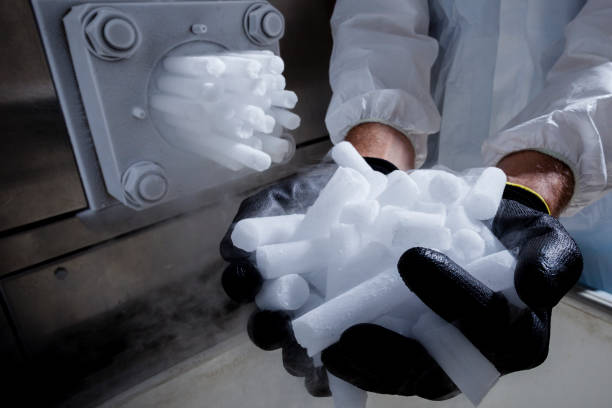Exploring the Fascinating World of Dry Ice: Everything You Need to Know

Are you curious about dry ice and its uses? Look no further! This article delves into the ins and outs of dry ice, from its properties and applications to safety precautions and disposal methods.
Introduction
Have you ever wondered what those smoke-like clouds are that appear in stage productions or at concerts? What about the cooling agent used to transport perishable goods across long distances? Look no further than dry ice, a solid form of carbon dioxide that is both fascinating and versatile in its applications. From entertainment to science and everything in between, dry ice has become an essential component in many industries. In this article, we will explore everything you need to know about dry ice, including its properties, uses, safety precautions, and disposal methods.
What is Dry Ice?
Dry ice is the solid form of carbon dioxide (CO2) at a temperature of -78.5°C (-109.3°F). It is created by pressurizing and cooling gaseous carbon dioxide, resulting in a solid that is odorless, colorless, and non-flammable. Unlike regular ice, dry ice does not melt into a liquid state; instead, it sublimates into a gas, skipping the liquid phase altogether. As dry ice sublimates, it releases carbon dioxide gas, which can be dangerous if not used in a well-ventilated area.
Properties of Dry Ice

Dry ice has some unique properties that make it an ideal cooling agent in various applications. Here are some of the properties of dry ice:
Temperature:
Dry ice has a temperature of -78.5°C (-109.3°F), making it a very effective cooling agent.
Sublimation:
Dry ice sublimates at room temperature, which means it turns directly from a solid to a gas without becoming a liquid.
Acidity:
When dry ice sublimates, it produces carbonic acid, which gives it a slightly acidic pH.
Density:
Dry ice is denser than regular ice, which means that a smaller amount of it can create a more significant cooling effect.
Uses of Dry Ice
Dry ice has a wide range of applications in various industries, including:
Food Industry
Dry ice is commonly used in the food industry to transport and store perishable goods, such as meat, fish, and vegetables. It helps to keep the temperature low and maintain the freshness of the products.
Ice Cream:
Dry ice is used to freeze and package ice cream, as it can rapidly lower the temperature of the mixture.
Catering:
Dry ice is used to keep food cold during catering events, such as weddings or parties.
Entertainment Industry
Dry ice has become a staple in the entertainment industry, especially in stage productions, concerts, and film shoots. It is used to create special effects, such as fog, smoke, and mist.
Concerts:
Dry ice is used in concerts to create smoke effects on the stage, making the performance more dramatic and visually appealing.
Movies:
Special Effects:
Dry ice is used to create special effects in films, such as creating smoke or fog in a scene.
Scientific Research
Dry ice is commonly used in scientific research and experiments. Here are some examples:
Cooling Agent:
Dry ice is used as a cooling agent in laboratories to keep samples and specimens at a low temperature.
Transportation:
Dry ice is used to transport samples and specimens across long distances, especially those that require a low temperature.
Experiments:
Dry ice is used in experiments, such as studying the behavior of different substances at low temperatures.
Other Applications
Apart from the above applications, dry ice has other uses, such as:
Cleaning:
Dry ice is used for cleaning surfaces, as it can remove stubborn stains and grime without leaving any residue.
Fire Extinguisher:
Dry ice can be used as a fire extinguisher, as it displaces oxygen, which is essential for fire to burn.
Insect Control:
Dry ice can be used to attract and trap insects, such as mosquitoes, as they are attracted to the carbon dioxide that it releases.
Safety Precautions
While dry ice is a versatile and useful product, it is crucial to take safety precautions when handling it. Here are some safety tips:
Storage and Handling
When storing and handling dry ice, keep the following in mind:
Wear Gloves:
Dry ice can cause frostbite, so always wear gloves when handling it.
Store in a Well-Ventilated Area:
Dry ice sublimates into carbon dioxide gas, which can be dangerous in enclosed spaces, so always store it in a well-ventilated area.
Use a Cooler:
When transporting dry ice, use a cooler or insulated container to prevent it from coming into direct contact with skin or other materials.
Disposal
When disposing of dry ice, follow these guidelines:
Do Not Dispose in the Trash:
Dry ice can create pressure in a sealed container, causing it to explode. Do not dispose of dry ice in the trash.
Allow It to Sublimate:
Place the dry ice in a well-ventilated area and allow it to sublimate completely before disposing of the container.
Do Not Touch:
Do not touch dry ice with bare hands, as it can cause frostbite.
FAQs
1. How long does dry ice last?
Dry ice typically lasts for 24-36 hours, depending on the amount and how it is stored.
2. Can you touch dry ice?
No, you should not touch dry ice with bare hands, as it can cause frostbite.
3. How is dry ice made?
Dry ice is made by pressurizing and cooling gaseous carbon dioxide, resulting in a solid that is odorless, colorless, and non-flammable.
Conclusion
In conclusion, dry ice is a versatile and useful product that has various applications in different industries, including food and beverage, healthcare, transportation, and scientific research. Its ability to maintain a low temperature makes it ideal for keeping items cold during transport or storage, while its unique properties make it a popular choice for special effects in films and TV shows.
However, it is crucial to take safety precautions when handling dry ice, such as wearing gloves, storing it in a well-ventilated area, and disposing of it properly. Failure to do so can result in serious injury or damage.
Overall, dry ice is an essential product that has many benefits, but it is important to use it safely and responsibly. Whether you need it for transportation, scientific research, or special effects, dry ice is a reliable and effective solution.
Dry ice
Temperature control
Special effects
Transportation
Safety precautions



